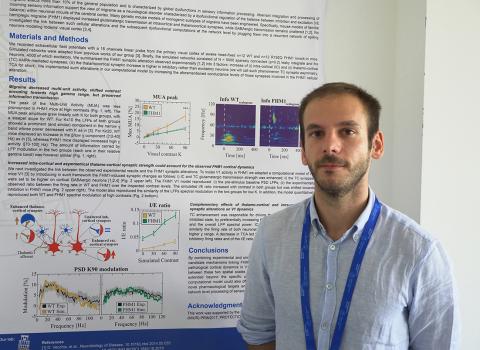Neuroscience, a study coordinated by The BioRobotics Institute identifies the relationship between migraine and light hypersensitivity. This is a new step to understand the mechanisms and behaviour fo visual neurons

Hypersensitivity to light is one of the most frequent symptoms of migraine. Indeed, migraine sufferers try to spend as much time as possible in the dark. Scientifically, this common experience has been considered contradictory because headaches lead to a decrease in the activity of neurons in the visual cortex. How do less active neurons lead to increased, even excessive, transmission of visual stimuli?
A study, resulting from the collaboration between The BioRobotics Institute, Sant’Anna School, the Institute of Neuroscience of the CNR in Pisa and the Department of Biomedical Sciences of the University of Padua, and published in the prestigious journal 'Journal of Headache and Pain', reveals that migraine is associated with an excessive synchronisation of neurons that makes us hypersensitive to visual stimuli.
A mathematical model for understanding neuron behaviour during migraine
“Our data analysis has highlighted two results: the first is that the activity of the migraineurs cortex in response to visual stimuli is decreased as compared to healthy controls. Despite their reduced activity neurons keep talking to each, and the second result is that migraine neurons pack their messages in a faster way, i.e., with a frequency pathologically enhanced” explains Nicolo Meneghetti, first author of the study and PhD student at The BioRobotics Institute.
"In order to understand the pathological behaviour of neurons, we always start with a mathematical model of healthy behaviour and then study how the changes that disease induces in individual neurons lead to changes in the dynamics of the network and thus to malfunctions," explains Alberto Mazzoni, head of the Computational Neuroengineering Laboratory at the Scuola Superiore Sant'Anna and co-coordinator of the project. "This is only possible with very close collaboration between those who acquire the data and those who analyse and model them, i.e. neurophysiologists and neuroengineers. Today's results in particular would not have been possible without Matteo Caleo, a professor at the CNR in Pisa and at the University of Padua, who conceived the work and guided its experimental aspects until his tragic and untimely death this spring. The work is dedicated to him'.
Migraine and not only
“This study might help the scientific community to develop new therapies to fight the pathology. Moreover, migraine shares some characteristics with other pathologies, such as epilepsy. Our model might therefore also help unravel some characteristics of these other pathological conditions” concludes Meneghetti.
Authors
Nicolò Meneghetti (Istituto di BioRobotica, Scuola Superiore Sant’Anna), Chiara Cerri (Istituto di Neuroscienze, CNR di Pisa), Eleonora Vannini (Istituto di Neuroscienze, CNR di Pisa), Elena Tantillo (Istituto di Neuroscienze, CNR di Pisa), Angelita Tottene (Dipartimento di Scienze biomediche, Università di Padova), Daniela Pietrobon (Dipartimento di Scienze biomediche, Università di Padova), Matteo Caleo (Istituto di Neuroscienze, CNR di Pisa e Dipartimento di Scienze biomediche, Università di Padova), Alberto Mazzoni (Istituto di BioRobotica, Scuola Superiore Sant’Anna)




